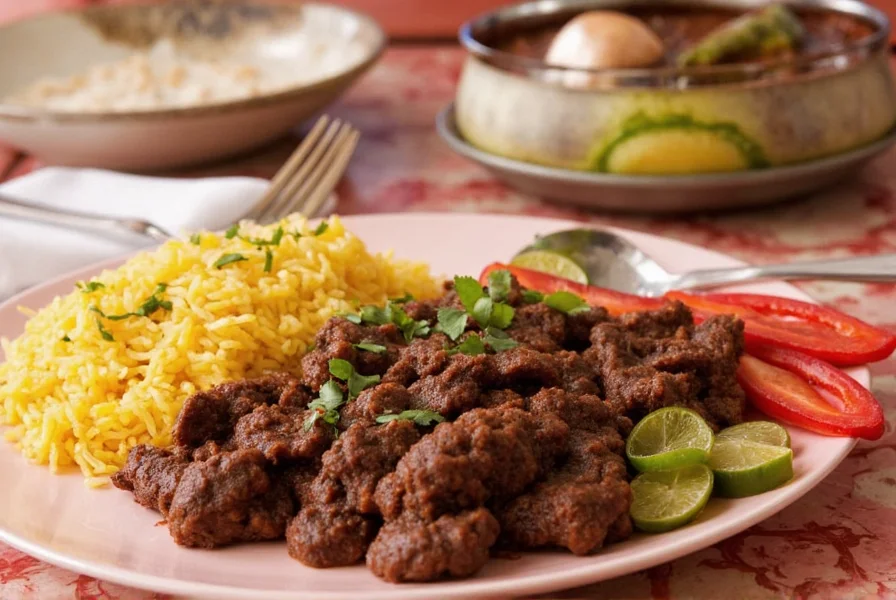Table of Contents
Ingredients
For authentic mole sauce (serves 6-8):
- 4 dried ancho chilies, stemmed and seeded
- 2 dried mulato chilies, stemmed and seeded
- 1 dried pasilla chili, stemmed and seeded
- 1/2 cup raw peanuts
- 1/4 cup sesame seeds
- 2 tablespoons pumpkin seeds
- 1 small onion, quartered
- 2 garlic cloves, peeled
- 1/2 cup raisins
- 1/4 cup almonds
- 1/2 cup unsweetened cocoa powder
- 1 (12 oz) Mexican chocolate bar, broken into pieces
- 1 teaspoon ground cinnamon
- 1/2 teaspoon ground cloves
- 1/2 teaspoon ground cumin
- 2 cups chicken or vegetable broth
- 2 tablespoons vegetable oil
- 1/2 teaspoon salt
Step-by-Step Instructions
Step 1: Toast and rehydrate chilies
Remove stems and seeds from dried chilies. Toast chilies in a dry skillet over medium heat for 30 seconds per side until fragrant. Immediately transfer to a bowl and cover with hot water. Let soak for 20 minutes until softened.
Step 2: Toast nuts and seeds
In the same skillet, toast peanuts, sesame seeds, pumpkin seeds, and almonds over medium heat for 3-4 minutes until golden. Remove from heat and set aside.
Step 3: Blend ingredients
In a blender, combine soaked chilies (drained), toasted nuts/seeds, onion, garlic, raisins, cocoa powder, cinnamon, cloves, cumin, and 1 cup broth. Blend until smooth.
Step 4: Cook the mole
Heat vegetable oil in a large pot over medium heat. Pour in the blended mixture and cook for 5 minutes, stirring constantly. Add remaining broth and chocolate pieces. Simmer uncovered for 45-60 minutes, stirring occasionally, until thickened to a smooth, velvety consistency. Season with salt to taste.
Step 5: Serve
Strain through a fine-mesh sieve for ultra-smooth texture (optional). Serve over chicken, pork, or enchiladas. Store in refrigerator for up to 5 days or freeze for 3 months.
Mole Variations
Mole Poblano (Classic)
Use 2 ancho, 2 mulato, and 1 pasilla chilies. Add 1/4 cup raisins and 1/2 cup almonds for traditional richness.
Mole Verde (Green Mole)
Replace dried chilies with 1 cup fresh tomatillos, 1/2 cup cilantro, 1 jalapeño, and 1 avocado. Use vegetable broth and omit chocolate.
Mole Negro (Black Mole)
Add 1/4 cup coffee and 1/2 cup plantains to the base recipe. Use 3 ancho and 2 mulato chilies for deeper color.
Pro Tips for Perfect Mole
- Balance flavors: If too spicy, add a teaspoon of honey. If too sweet, add a pinch of cayenne.
- Texture control: For thicker mole, simmer longer. For thinner consistency, add more broth.
- Make ahead: Mole tastes better the next day as flavors meld. Freeze in portions for quick meals.
- Storage: Always cool completely before refrigerating. The fat layer that forms on top is normal and can be stirred back in.
Frequently Asked Questions
Can I make mole without chocolate?
Yes! Traditional Mole Verde and Mole Amarillo don't contain chocolate. For chocolate-free versions, replace it with extra cocoa powder or omit entirely.
Why is my mole bitter?
Over-toasting chilies or overcooking the sauce can cause bitterness. Remove chilies from heat immediately after toasting and simmer no longer than 60 minutes.
What's the best protein to pair with mole?
Traditional choices include roasted turkey (for Mole Poblano), pork shoulder, or chicken thighs. For vegetarian options, try roasted sweet potatoes or mushrooms.
How do I fix mole that's too thick?
Gradually whisk in warm broth or water until desired consistency is reached. Avoid adding cold liquid as it may cause lumps.
Can I use store-bought mole paste?
Yes! For quick versions, use 1/2 cup store-bought mole paste diluted with 1 cup broth. Simmer 15 minutes to develop flavors.
Is mole gluten-free?
Traditional mole is naturally gluten-free. Always check labels on store-bought ingredients like chocolate and broth to confirm.
How long does homemade mole last?
Refrigerated: 4-5 days in airtight container. Frozen: up to 6 months. Always check for off smells or mold before using.
What makes mole different from other sauces?
Mole's complexity comes from its 20+ ingredients and layered cooking process. Unlike simple sauces, it balances sweet, spicy, smoky, and earthy flavors through careful toasting and blending.











 浙公网安备
33010002000092号
浙公网安备
33010002000092号 浙B2-20120091-4
浙B2-20120091-4